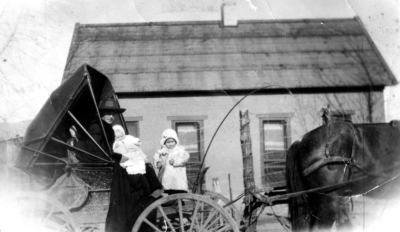By CHERYL JENSEN
The Progress

The Virgin Valley communities are rich in their early pioneer history. And many vestiges of that history can still be seen here. For example, the early settlers of the Virgin Valley built their homes here, some of which are still in use today.
These early homes were the subject of a recent presentation given by Elspeth Kuta , Director of the Virgin Valley Heritage Museum.Kuta showed photo of early homes in the Virgin Valley and talked about the early settlers who built them.
When they first arrived in the Virgin Valley, settlers lived in tents and wagons for a time. They often built a temporary bowery with poles topped with brush and sides of wood.
“That is where they would cook and wash clothes in a tub,” Kuta said.

Later the settlers used the natural resources available to them here to build more permanent structures. These included rock dwellings or adobe homes made from mud bricks. Wood for beams came from Hancock Canyon in the nearby mountains where there was a saw mill.
The oldest home in Mesquite was built in 1880. It is now located at the corner of Willow and First North. This home was continually lived in until 2003 when it was sold to the city of Mesquite to preserve the historic home. It is a small rectangle with walls about 18” thick keeping it cool in the summer and warm in the winter with the fireplace made of river rock.

The one room rock house was made from natural rock from the hills north of town and “layed up” with clay and sand mortar. A lean-to was added on the back in 1910 and in 1970 an indoor bathroom was installed.
“The city has plans to someday restore this old home and make it open to visitors,” Kuta said.
The homes in the early era often started out as a simple rectangle. Then a lean-to was added on one side. Later another lean-to of wood or rock was added on the other side. The homes often had a porch which served as a kitchen with a cream separator and milk pans.
The Howard Pulsipher home was the first home with indoor plumbing, Kuta said.
“It was such a novelty that all the kids in the town had to come over and watch the water flush!” Kuta said with laughs from the audience.
In 1904 James Elmer and Sarah Ann Burgess Hughes came from Wales with all three generations of their family. They built a home similar to the architecture of Wales. They operated the post office which was built in front and they added a sleeping porch on the back with screens to keep the mosquitos out.
Kuta also read Sam Reber’s story of how they dealt with mosquitoes in Littlefield. “We had smudge pots filled with cattle dung and would light them at night near our outside cots,” Reber wrote. “The smell was horrible! Next day at school everyone wanted to keep away from me. I would rather get stung than have to go to school smelling like cow dung!”
Thirza Leavitt’s rock house had a fireplace at either end, there were two front doors and a window with a wall between. This structure was similar to many early homes of polygamous families. Each wife could have her own space.
The William E. Abbott home is still standing on the corner of Mesquite Blvd. and Sandhill. It cost $7,000 to build. Abbott traded his team for windows and doors and the interior woodwork he obtained by trading land in Bunkerville.
The Abbotts were known for their hospitality and Mary Jane never turned anyone away. “She always provided lunch for visitors, even if it was just beans and bread,” Kuta said. “Sometimes as many as 50 people were fed lunch.”
The Dudley Leavitt home is a two-story home in Bunkerville which was made of brick. It is still in use today with a small rock house in the back yard. The Fabbin brothers, who were brick masons, built the home. Luella lived in the large home. But Ada, the plural wife, resided in a small rock house by the side.
Samuel Reber built a home of cement block in 1919 near his vineyards. He had planted acres of Thompson seedless grapes which they dried on screens making raisins and then boxed up in 20-40 lb. bunches. These were traded for root vegetables in Utah.
“The area off of Grapevine and with street names of various varieties of grapes was the place of the vineyard,” Kuta explained.
Howard Pulsipher had the small tithing house next to his home. “There was not a lot of cash for people to pay their ten percent to the Church,” Kuta said. “So they gave produce or other items.”
The tithes were stored in the tithing house and then given to those in need or people passing through who were in need.
Pulsipher also owned Howard’s Gas Station where many visitors would stop as they passed through. “Howard’s wife would notice the need of some families when people stopped for gas,” Kuta said. “She would give them food and clothes to help them on their way.”
Kuta told a heartwarming story of the 1916 basketball team’s victory at the state championship in Reno. It started out with the sad tale of a windstorm destroying the home of Harmon and Lillian Tobler. But it left the wood floor intact.
The basketball team had only played on a dirt area outside, so they cleaned off that wood floor and the team practiced on it for the competition in Fallon, Kuta said.
When the team got to Fallon, they were a little more prepared to play on a gym floor. They won by two points!
“Then they went to state in Reno and won playing in a large gym even though they had never played in a gym before,” Kuta said. “They won the game much to the astonishment of the opposing team who had had all the advantages of wood floors and an indoor gym all along!”
Valate Hughes Hardy and her father built a home with a basement for $1,400. Kuta showed a picture of Valate Hardy, age 90, in front of her home holding a beautiful doll.
“When Valate turned 90 her family wanted to have a birthday party and wanted to know what they could get her,” Kuta said. “She said she didn’t need anything at 90 years of age.”
They kept asking her, though. Finally Valate admitted that she wanted something that she had never had before: “a store-bought” doll.
“And so, at age of 90 the family bought Vilate her first doll which she carried everywhere until she died,” Kuta said. “It meant so much to her!”
The home of Ralston and Myrtle Reber is still standing on Leavitt Lane. It was built in 1930 with three courses of adobe brick – making 14,000 bricks.
The Relief Society house was built on the west side of Willow Street in 1929. It was built as a gathering place for local women to make quilts and learn food preservation skills. They also collected and stored extra food to give to those in need.
The house was later sold when the new church building was built and it was used as a home for the Wes and Verd Hughes family for many years. Because of a planned development, this old building was recently moved across the street so it can be preserved and will be open for tours and events.
More information about these homes and other historic structures is available at the Virgin Valley Heritage Museum located at 35 W. Mesquite Blvd. The museum is open Tuesdays through Saturdays from 10 am to 4 pm.








![ElectionAd [Recovered]2](https://mvprogress.com/wp-content/uploads/2024/05/4-24-2024-FC-ElectionAd-Finalv3.jpg)


1 thought on “A History Of Early Homes In Virgin Valley”
Enjoyed reading this, but wanted to make a correction. The two story adobe home at the top of the article was not Dudley’s home. It belonged to his nephew THOMAS DUDLEY LEAVITT. This is a common confusion. Thomas Dudley was my grandfather, in fact my father Lorin(Dutch) Leavitt was born in the northwest room of the ground floor of this house in 1909. In the photo it would be the bottom left corner room. Dudley and Thomas Dudley are often confused. Thomas Dudley’s dad was Dudley’s brother Lemuel Leavitt.